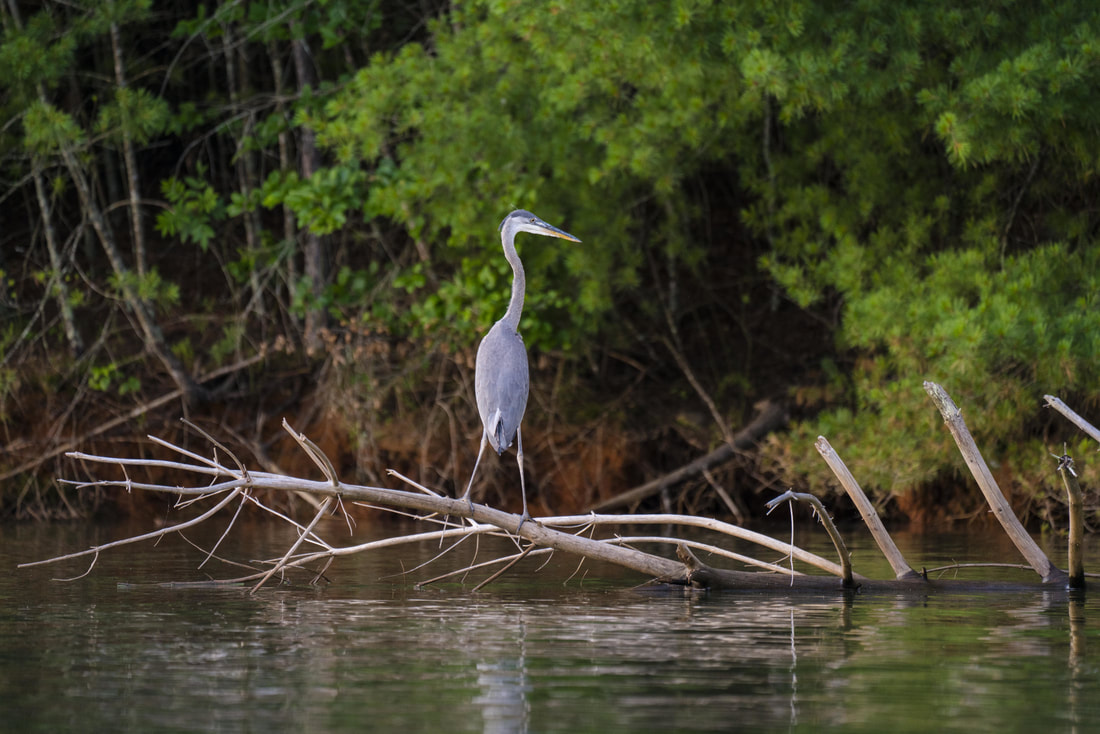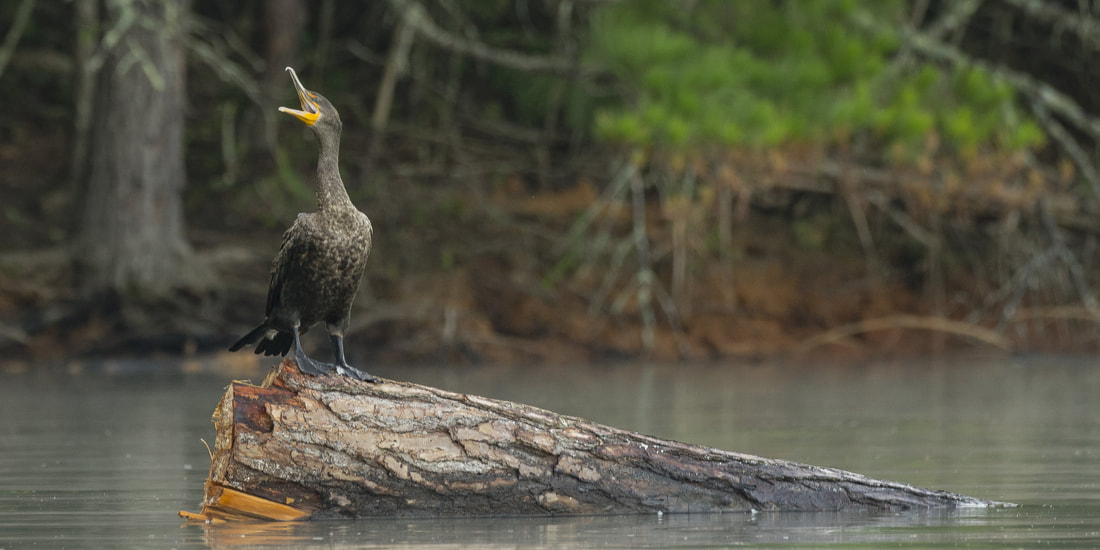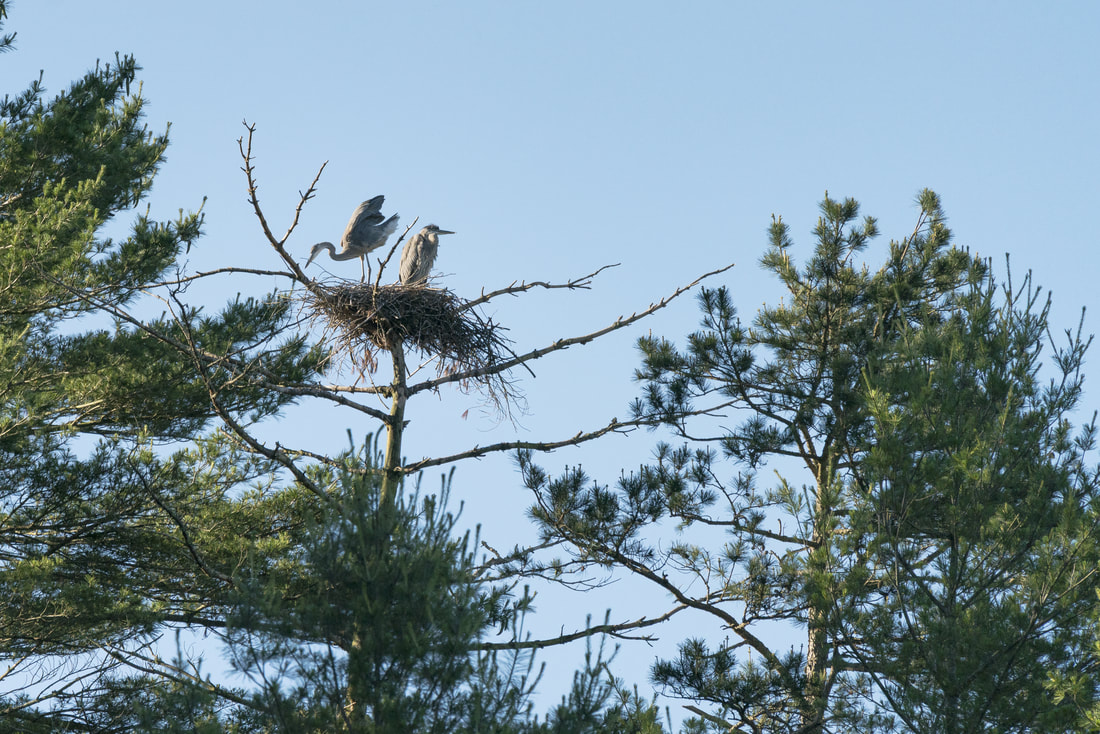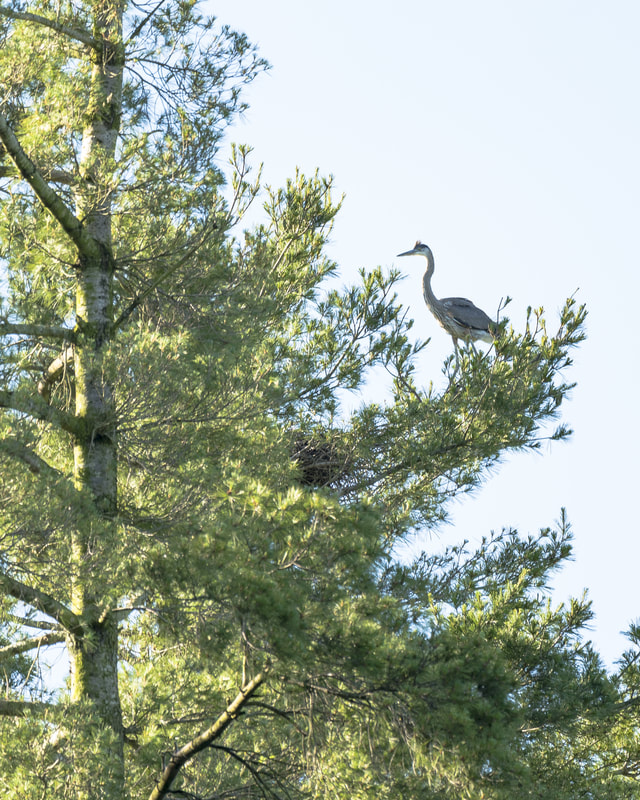|
One of my favorite wildlife photographers is Thomas Manglesen who lives in Jackson, Wyoming near Yellowstone and Grand Teton parks. Tom has made a life out of capturing moments in the wild. and many of his images are spectacular. You can see some of his images at this link. Tom teaches that wild animals have comfort zones around them. If you get within them they will react, usually by leaving. He also notes that walking directly towards a wild animal will cause them to react sooner than if you approach them by walking at an angle. Near a herd of Bison, he takes his students back and forth walking sideways to the herd to get closer. He also teaches that you can sometimes float close to a wild animal if you stay still and let the current take you toward the animal.
While floating I grabbed my camera out of its waterproof bag, and took a few photos while I drifted silently closer. The early evening light was perfect for the photo shoot as was the dark green and brown background of the island behind him. I adjusted the camera's aperture to obscure the background and highlight the bird. As I drifted, I watched and shot photos as he moved around. He seemed oblivious to me and the large orange "log" I was sitting on. And, as you can see, he continued his fishing. At this point, I was a good 10 minutes into my silent float and less than 20 yards from the bird. He was aware of me and looked at me from time to time but then went quickly back to his business, even lowering his head to get a drink of water. It was not until I drifted within 10 yards of him, that he finally started to think about flying off. When he did, it was with no sign of alarm. He just pulled himself up and flew off. I counted my blessings. I have been on the water for years without ever getting this close. I sat for a minute and started to think about packing up the camera. As I started to reach for the paddle, however, something told me to look around. When I did, I was greeted with this scene just 25 yards upstream. The heron or one of his cousins had landed in some floating brush and had no concerns about the floating orange lob nearby. All photos and text are copyright by Clinton Richardson. Moe images from the Jurassic Cove Gallery can be found at TrekPic.com, click New on the home page to be directed to the gallery.
If you like these posts, please tell your friends about the Venture Moola blog at Readjanus.com. And, feel free to share this blog. The more readers the better. Click here to subscribe to a weekly email that tells you when we issue new entries. Or, click in the column to the left to follow us on Facebook or Twitter. It surprises me how much traffic some of my older more business oriented posts continue to generate. Maybe its the audience or maybe its the challenge of launching a new business that is just plain interesting. As the photos in this post demonstrate, launching anything requires effort, determination, and skill. A business is no exception. Starting requires you to announce yourself and your ambition to the world. And, even though the person starting the business builds a team to work with through the many challenges the company will face, there is still a very real sense in which the entrepreneur is going it alone. No matter how good and motivated the team is, most founders discover that there is no one in the company they can share everything with. Perhaps this is part of the reason a good outside lawyer can be so important to a growing business. There are things you can share with outside advisors that you just would not be comfortable sharing with employees. And then there is the blur. There is so much to know and so little inherent credibility in a new business that, for most, long hours and novel challenges are the norm. Sometimes you run full speed just to stay put. And, much of the time things can seem like a blur. To succeed, you have to learn on the fly (sorry for the obvious pun) and mistakes happen. Sometimes big ones. And, despite your faith in your innovative business and your team, sometimes you feel more like you are falling than flying. But notwithstanding the challenges and the bumps in the road (or splashes in the lake), the ride is exhilarating. For many of the entrepreneurs I worked with and observed, the act of accepting the challenge and running a business brought them a fuller reality.
I know this was the case with my father. He never seemed more engaged or alive than when he was running his own business. Perhaps this is why the topic is interesting to so many. So, what are you seeing in the pictures? These images are of a lone cormorant taking flight on a North Georgia lake. _ _ _ _ _ _ _ _ _ _ Next week we talk about grizzly jam. All photos and text are copyright Clinton Richardson. If you like these posts, please tell your friends about the Venture Moola blog at Readjanus.com. For more pictures of the cormorant or the great blue herons whose territory he is invading, see the Jurassic Cove Gallery at TrekPic.com under the heading New. And, feel free to share this blog. The more readers the better. Click here to subscribe to a weekly email that tells you when we issue new entries. Or, click in the column to the left to follow us on Facebook or Twitter. A heron's nest. That is what I was looking for. You could hear their racket from the other side of the cove. And, when you ventured out in the morning in your kayak, you could see the herons flying in and out of a stand of pine trees that stood near the bank of the island on across the cove. When they arrived, you could hear more chatter from chicks hungry for what they brought. That evening, I made it my goal to find the nest. After rowing out and a little patient looking, I saw it high above near the top of the tallest of five pine trees that stood on the edge of the island. And, after awhile longer an adult heron flew in and went right to the nest. Success. At the same time, I noticed other herons nearby flying and others, still, sitting in nearby pine trees. Some seemed smaller than the adult who had flown into the nest. Results of an earlier hatch, I guessed. I was lucky to get here early enough to witness the second hatch. At least, that is what I thought. While I was out, I captured a picture of this youngster making noise. Funny thing was, however, this was not the nest in the top of the tallest of five pines. It was two trees over. Had my first sighting been an inactive nest? Or, and I was considering this for the first time, could there be two active nests so close together? The camera captured this chick much better than I could with my unaided eyesight. He was little more than a blur in a nest that emerged as I was watching his parent depart. So, I really first saw him with his black head bristle and claws emerging from his wing, when I went through my images later that night. Encouraged by the picture, I headed back out the next morning hoping to see and photograph more. This time I had more time and an expanded vision of what I was seeing. I was not just looking for a nest or two. Instead, I was hoping to find out whether I was seeing was something unthinkable to me just a year earlier. Could this be a colony of Great Herons? Could there possibly be more nests? I stationed myself first in the water where I could see clearly a nest, a third one three stories above, that sat on the top of a dead tree. It was perfect for viewing two chicks standing upright in the nest. I waited patiently for things to happen while periodically maneuvering my kayak to keep an unobstructed view. With the aid of time and a 400 mm lens, I was rewarded with a visit from mom and dad. As you can see below, they arrived together and quickly determined that there was room enough for only two on the nest. Here is the crash scene as it unfolded. Neither parent made it onto the nest. Time to wean these two chicks. The time spent waiting was rewarded in other ways too. As was the time afterward rowing to other vantage points. What I found were multiple nests, many with parents sitting nearby. At least a dozen that I could count. Who knows how many more there might be deeper in the island. The two photos below are typical of what I saw. Come to your own conclusion, but I believe we found a Great Blue Heron colony. Dozens of nests with chicks at different levels of development from the nearly full grown behemoths we saw above to chicks so little you cannot see them from 30 feet below, even with the longest of lenses.
And, I have had a practical lesson in discovery and the power of preconceptions to color perception. Last summer I was certain I was seeing a single herons nest and could not see what was really there. The herons sitting in nearby trees I dismissed as first hatch lookers-on. Instead, they were part of a nesting colony right under (or, should I say above) my nose. With more time and a closer look this year aided, certainly, by a long lens, I discovered much more than I anticipated. And, changed my understanding of what I saw. I think this is part of what I like about photography. It has the power to show you things you would not otherwise observe. The long lens can take you closer to your subject showing you detail you would otherwise miss. And, the whole process slows you down and gives you time to digest what you are seeing. And, the cove? After seeing the first chick photo above, I have given it a new name. I now call it Jurassic Cove. Next week's posting falls on the birthday of a long lost brother. We will take the opportunity to remember him and his unique sense of humor. Be prepared for George Carlin meets the advertising industry. All photos and text copyright Clinton Richardson. These and other images from what I affectionately call Jurassic Cove are posted on our TrekPic.com website. Click on New on the homepage to be directed to the gallery. If you like these posts, please tell your friends about the Venture Moola blog at Readjanus.com. And, feel free to share this blog. The more readers the better. Click here to subscribe to a weekly email that tells you when we issue new entries. Or, click in the column to the left to follow us on Facebook or Twitter. Sadly, Clay's Corner, extraordinary gas station, meeting place and host to the unique New Year's Eve Possum Drop is no more. Clay has retired and the station and Possum Drop that marked the beginning of each new year in Western North Carolina are now relegated to a past tradition.
No more country bands at Clay's Corner to accompany the dropping of a live possum in time with the new year's beginning. No more celebration of this unique but abundant creature. Locals who have enjoyed the tradition for years must now find other entertainment. PETA advocates, however, are probably quietly celebrating the news. To see more images of the self proclaimed Opossum Capital of the World and other unique images from the Blue Ridge area of Northern Georgia and Western Carolina, check out Blue Ridge Gallery in the Close to Home Collection at our TrekPic.com photo website. "Welcome to Clay's Corner" image above courtesy of TrekPic.com. Text and image are copyright Clinton Richardson. If you like these posts, please tell your friends about the Venture Moola blog at Readjanus.com. And, feel free to share this blog. The more readers the better. Click here to subscribe to a weekly email that tells you when we issue new entries. Or, click in the column to the left to follow us on Facebook or Twitter. We are introducing something new to our TrekPic.com photo resource.
Check out the New page and Coins pages when you are there. In addition to our works that inform (Ancient Selfies and the Growth Company Guide 5.0), we will now be including photographic 'images that inspire' with links to our TrekPic resource. The image was taken in late Spring from a relatively remote spot on the South Rim of the Grand Canyon. A mile long hike through a light snow and past a tree recently maimed by bears was all that was needed to reach the site. The reward was the chance to see and feel a snow storm sweep toward Shoshone Point just after dawn. Shoshone Point is shown on the right. TODAY WE TAKE A BREAK FROM BUSINESS to answer some questions posed by readers about an earlier post. Specifically, questions about my experiences with night photography from readers of this blog. Thanks for your interest in the topic.
Those who know say it takes between 30 and 45 minutes until your eyes fully adjust to the night so that you can see well under a star filled sky. You learn these kinds of things when you take up night photography and have to manipulate the controls of a full frame camera in the dark. Shine a regular flashlight at the camera and your adjustment time begins anew but use a red light and you be able to see without resetting your eyes to daylight mode. This is another thing you learn and the reason why you see small red lights shining here and there when you photograph the Milky Way from a dark site with other photographers. The first time I ventured out into the middle of the night to try and photograph the night sky was a few years ago while we were visiting Arches National Park in Utah. It felt a bit weird heading out into the dark alone. Much of our obsession with lighting our cities and homes, I think, reflects a longstanding fear we have of the dark. It can be unsettling being in the dark when you can hear but cannot see what is going on around you. Trying something new and unfamiliar was part of what motivated me to night photography in the first place. You could see the Milky Way in the night sky from my suburban neighborhood when I was a kid long ago. I remember the awe we all felt on a clear moonless night when the Milky Way showed best. In most cities now, that’s not a realistic option because of how much more light we flood our skies with. So my other motivation was to visit a sky again that I already knew but had, like most of us, lost. On my first night in Arches a few years back I had the skies mostly to myself. My only company was a pack rat who kept running in and out of the beam of my flashlight and, after an hour or two, a male voice from the parking area nearby wanting to know what I was doing. Eventually, the voice turned into a man named Art who had read about night photography and walked over to watch the process. Otherwise, it was just me, the sky and an occasional car driving by on the park road. In the few years that passed between that outing and my trip to Utah this Spring, cameras have improved and much has been written about photographing the night sky. So, I was not sure what to expect this time. Would there be more people out taking photographs? Would I get better pictures? The first clear night skies we had was at Capitol Reef National Park in late April. Heading out at 2:00 a.m. to catch the Milky Way without the moon, I drove 15 minutes into the Park, set up and shot for a few hours before returning to the motel. I did not see a single person or car. The cold, the quiet, the spectacularly lit sky and the isolation were invigorating. A few days later, also late into the night but this time at Arches National Park, I found myself in the company of others. In fact, the place was alive with photographers of different skill levels speaking multiple languages. It was the new moon which is ideal for shooting the Milky Way but the bigger difference had to be the existence of camping grounds within the park. The extra photographers made the process more challenging as people would flood an area with headlights or flashlights messing up your vision and your shots. But it also had the feeling of an event, with folks sharing an interest and working together to get shots. And, some of the shots were beautiful. My latest trip was to a park designated a Dark Sky Site by the International Dark Sky Foundation. The site consisted of a long shoreline overlooking lake Michigan that you accessed by walking through the woods on an unlit path for a little over a mile. While walking down the path my eyes adjusted to the dark and I could get glimpses of the sky through the trees. When I arrived at the shoreline the sky was filled with the light from the Milky Way and there were dozens of people on the beach enjoying the star filled sky. A few had cameras but most were spread out on blankets enjoying the dark and the night sky. If you have an interest in getting out yourself, let me know. This posting is in response to questions asked since my first posting about the night skies. The photograph above is copyright Clinton Richardson 2016. It was taken along the shore of Lake Michigan at Headlands State Park in Northern Michigan. |
the blog
Travel, history, and business with original photos.
your hostClinton Richardson - author, photographer, business advisor, traveler. Categories
All
Archives
July 2023
Follow us on Facebook
|
Check out Ancient Selfies a 2017 International Book Awards Finalist in History and 2018 eLit Awards Gold Medal Winner and
Passports in his Underpants - A Planet Friendly Photo Safari a 2020 Readers' Favorite Winner in Nonfiction
Site Copyright 2024 by Clinton Richardson





















 RSS Feed
RSS Feed